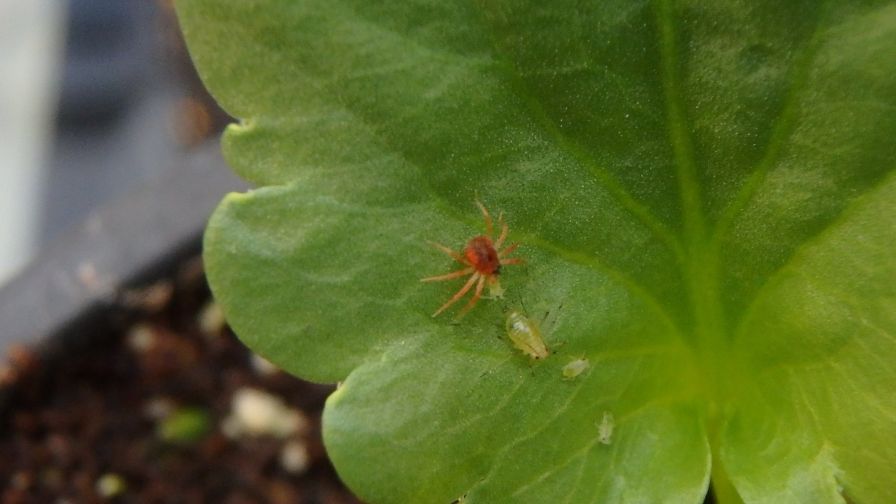Anystis: Building a New Predatory Mite from Potential to Product

Anystis on Foxglove Aphid; Photo Taro Saito
It is very exciting to see a new biocontrol agent, one we have been working on for such a long time, make its way into the real world. Last spring, the transfer of the predatory mite, Anystis baccarum, to Vineland Research and Innovation Centre’s commercial partner, Applied Bio-nomics Ltd., was a milestone that capped off more than 10 years of research.
The discovery of the predator by Taro Saito, Senior Research Technician at Vineland, was described in a previous article, “Plant researchers on the hunt for new biocontrol agents” (Greenhouse Grower March 2020).
Anystis mites are commonly called whirligig mites, because of their characteristic random zig-zag searching behavior. In Japan, they are know as leaf guardian mites. This is also an apt name, as naturally occurring populations of this mite are considered important natural enemies of pests in crops worldwide, such as orchards in the United Kingdom, vineyards in Canada, cereals in Russia, tea fields in China, and organic potato fields in New Zealand.
Despite their good performance in the field, Anystis was never commercialized as a biocontrol agent, because no one could figure out how to economically mass rear this predator due to its cannibalistic behavior. Taking on this challenge, the research team led by Saito has successfully maintained a colony at Vineland for more than 10 years and scaled it up into a cost-effective mass rearing system.
Predation Capacity
Anystis is an extremely generalist predator. We often joke that it tries to eat everything that it runs into. Indeed, we have observed it to attack many common greenhouse pests such as thrips, spider mites, whiteflies, and aphids. It not only feeds on the vulnerable immature stages, but also manages to catch more mobile adults. For example, see this video where it attacks whitefly adults. We have seen it prey on pests that are not well controlled by biocontrol, such as echinothrips, mealybugs, soft scale, and some of the more challenging aphid species, including root aphids. Finally, it feeds on pollen, and several supplemental food sources such as Ephestia eggs and Artemia cysts.
Two in-depth research trials demonstrated Anystis’ potential to control Western flower thrips and foxglove aphids. The results of this research were published recently as scientific articles (thrips article is in press; foxglove article). In the laboratory, Anystis consumed twice the number of thrips first instar larvae compared to Neoseiulus cucumeris. In addition, it also attacked the larger second instar and adult thrips that N. cucumeris are not able to kill. In a research greenhouse trial on potted chrysanthemums, a few Anystis adults provided similar control as a breeding sachet of N. cucumeris and a combination of the two predators reduced thrips to almost zero. We saw similar results with foxglove aphids. In the laboratory, one Anystis mite reduced aphids on a pepper seedling by 70% in just three days. It consumed adult aphids, but especially went after the aphid nymphs. A greenhouse experiment on peppers showed that combining Anystis with the parasitoid Aphidius ervi controlled aphids quickly, and better than the parasitoid alone.
Early commercial trials in cut gerbera and sweet pepper showed that Anystis was able to establish and persist in the crop. Now that Anystis is available in Canada, more growers are trialling this new product, so we hope to have more data on how it performs under commercial conditions soon.
Role in IPM Programs
As a generalist predator, Anystis is at the top of the food chain. According to several research studies, adding such a generalist predator can strengthen and stabilize IPM programs. Due to its wide range of prey, Anystis can establish in a crop in a preventative manner and provide base-line control of multiple pests. Combined with the regular, more specialist biocontrol agents, it will prevent outbreaks and bring pest populations down to very low levels.
One concern was that Anystis would also prey on any biocontrol agents, a behavior called intra-guild predation. Therefore, we tested the compatibility of Anystis with several commonly used biocontrol agents including N. cucumeris, Amblyseius swirskii, Stratiolaelaps scimitus, Orius insidiosus, and Delphastus catalinae. In addition, Applied Bio-nomics put Anystis together with Aphidoletes aphidimyza, Micromus variegatus, Phytoseiulus persimilis, Neoseiulus fallacis, Gaeolaelaps gillespiei, and Encarsia formosa. We only saw interference when Anystis was confined in a small Petri dish with the thrips predatory mites. Note, however, that these experiments were done in the laboratory in a worst-case scenario and that in a real crop, alternative food sources and escape routes are widely available to prevent these kind of negative interactions.
Release Recommendations
As a new product, the best rates and release methods are still guess work. Overall we have observed good pest suppression with just a few Anystis. For our research trials, we often released one adult per plant and repeated this two to three times, depending on the pest pressure. After a single release, a new generation will start emerging four to six weeks later. The use of supplemental food such as Ephestia eggs or Artemia cysts will help the predator establish the population.
Anystis will tolerate both low temperature and low light. We observed it to feed and lay eggs when kept in a dark incubator at 50°F. In a greenhouse, Anystis tends to hide during the hottest time of the day, and prefers the humidity above 50%. Although Anystis is found in many types of plants in the wild, including herbaceous, grass, shrubs, and trees, our preliminary observations indicate that Anystis may not establish in tomatoes, due to the granular trichomes on the stems, or in plants with smooth and slippery stems like roses and poinsettias.
Further Research
We hope to be able to demonstrate the potential of Anystis in even more crops. In collaboration with students of the Commercial Cannabis Program at Niagara College in Ontario, Canada, we found that Anystis establishes and reproduces on cannabis plants. The next step will be to demonstrate efficacy on cannabis aphids and rice root aphids, in addition to control of thrips and spider mites.
Anystis is also found frequently in field strawberries, which makes us wonder if it can be adapted to greenhouse strawberry and contribute to control of aphids, thrips, spider mites, and possibly Lygus and spotted wing drosophila.
Availability Outside Canada
This species, Anystis baccarum, is described as a cosmopolitan species, which means it is found all over the world. In principle, this should make it easier to obtain import permits to ship this species to places outside Canada. Unfortunately, the process to apply for the right paperwork takes time, so for now Canadian growers are the lucky ones that get to play with this exciting new biocontrol agent.









